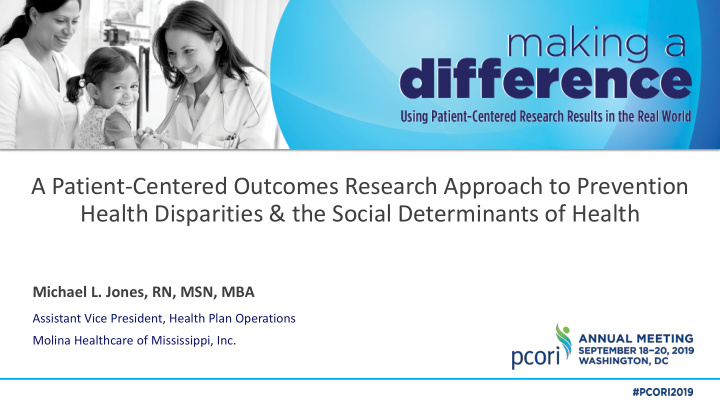



A Patient-Centered Outcomes Research Approach to Prevention Health Disparities & the Social Determinants of Health Michael L. Jones, RN, MSN, MBA Assistant Vice President, Health Plan Operations Molina Healthcare of Mississippi, Inc.
Michael L. Jones, RN, MSN, MBA • Has nothing to disclose. 2
Health Disparities & the Social Determinants of Health Consider This: • Where and how one lives has a direct impact on his or her health outcomes. • When addressing health issues, we must focus on prevention as well as focus on the root cause of those issues. • Addressing health disparities is key! • Addressing the Social Determinants of Health is essential! 3
What are Health Disparities? Differences in incidence, prevalence, morbidity, mortality, or survival rates compared to the health status of the general population. 4
Healthcare Disparities Differences between groups in health coverage, access to care, and quality of care. 5
Health Equity Health equity is achieved when every person has the opportunity to “attain his or her full health potential” and no one is “disadvantaged from achieving this potential because of social position or other socially determined circumstances.” (Centers for Disease Control and Prevention, 2014) 6
Determinants of Health “Determinants of health are factors that contribute to a person’s current state of health. These factors may be biological, socioeconomic, psychosocial, behavioral, or social in nature.” (Centers for Disease Control and Prevention, 2014) 7
Social Determinants of Health (as defined by the CDC) “Social determinants of health are economic and social conditions that influence the health of people and communities. These conditions are shaped by the amount of money, power, and resources that people have, all of which are influenced by policy choices.” (Centers for Disease Control and Prevention, 2014) 8
Social Determinants of Health (as defined by the WHO) “Social determinants of health are conditions in which people are born, grow up, live, work and age, including their health. These circumstances are in turn shaped by a wider set of forces: economics, social policies, and politics.” (World Health Organization, 2010) 9
Social Determinants of Health (as defined by the WHO) There are Ten (10) Components: The Social Gradient Stress Early Life Social Exclusion Work Unemployment Social Support Addiction Food Transport (World Health Organization, 2010)
Social Determinants of Health Ten Components Component Explanation 1. The Social Gradient Life expectancy is shorter and most diseases are more common further down the social ladder in each society. 2. Stress Stress is damaging to health and may lead to premature death. 3. Early Life The health impact of early development and education lasts a lifetime. 4. Social Exclusion Hardship and resentment, poverty, social exclusion, and discrimination costs lives. (World Health Organization, 2010)
Social Determinants of Health Ten Components (continued) Component Explanation 5. Work Stress in the workplace increases the risk of disease. People who have more control over their work have better health. 6. Unemployment Job security increases health, well-being, and job satisfaction. Higher rates of unemployment causes more illness and premature death. 7. Social Support Friendship, good social relations, and strong, supportive networks improve health at home, at work, and in the community. (World Health Organization, 2010)
Social Determinants of Health Ten Components (continued) Component Explanation 8. Addiction Individuals turn to alcohol, drugs, and tobacco, and suffer from their use, but use is influenced by the wider social setting. 9. Food Because the global market forces control the food supply, healthy food is a political issue. 10. Transport Healthy transport means less driving and more walking and cycling, backed up by better public transport. (World Health Organization, 2010)
Social Determinants of Health Conceptual Framework (World Health Organization, 2010)
Health Literacy Health Literacy is also an issue! What is Health Literacy? “Degree to which individuals have the capacity to obtain, process, and understand basic health information and services needed to make appropriate health decisions”. (National Institutes of Health, 2010) Thursday, November 7, 2019
Implications of Low Health Literacy? • Difficulty managing medical conditions • Increased medication errors • Lack of knowledge of available health resources • Low adherence to health provide instructions • Increased hospitalizations • Increased emergency utilization • Poor health status health .gov
Summary • Addressing every aspect of the individual is essential to improving health outcomes. • We must address the environment in which one lives and work to remove any barriers that may exist. • We cannot forget about the issue of Health Literacy • More work is needed at the community level to ensure positive health outcomes of communities. Thursday, November 7, 2019
References • Centers for Disease Control and Prevention (2016) • National Institutes of Health (2010) • National Assessment of Health Literacy (2010) • United States Census Bureau (2012) • World Health Organization (2010) • www.health.gov
Learn More • www.pcori.org • info@pcori.org • #PCORI2019 19
Questions? 20
Thank You! Michael L. Jones, RN, MSN, MBA Assistant Vice President, Health Plan Operations Molina Healthcare of Mississippi, Inc. September 19, 2019 21
Recommend
More recommend